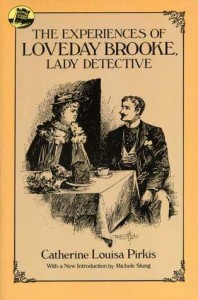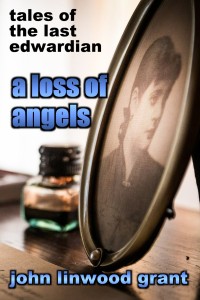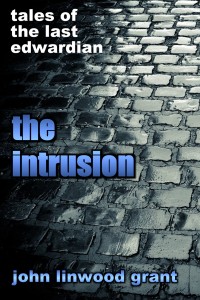or “Writing Edwardian Female Detectives – Do You Feel Lucky, Common Person?”
I’m a guilty fan of the Murdoch Mysteries. I don’t know if you’ve ever seen it. It’s a Canadian TV detective programme, set in the late 19th and early 20th centuries. Very inventive, often amusing, and packed with guest appearances by real historical figures, including Tesla, Edison, Conan Doyle, Houdini and H G Wells. Based (rather loosely) on Maureen Jennings’ Murdoch novels, it’s up to at least Series Seven by now.
Its relevance to this blog entry is the fact that it has female police pathologists, two intelligent women determined to make their mark. The first one eventually goes off to become a psychiatrist (I like the early term alienist better). Her successor is just as thorough and talented, though a bit more of a laugh. And they have aspects to their lives which do not involve husbands/boyfriends, including their work on female suffrage. I quite like them.
So many of my favourite collections, late Victorian and Edwardian detective stories, have no women in them in any meaningful role. Plenty of background wronged wives, jilted fiancees and unfortunate female victims, but the brainwork is almost always done by men. Boring.
There are exceptions. Andrew Forester’s Mrs Gladden, a police agent, for one, but not all of the late Victorian stuff is easy to read nowadays. The Experiences of Loveday Brooke, Lady Detective (Catherine Pirkis) is also worth a look.

Quite readable, for the most part, is the Edwardian Lady Molly of Scotland Yard, by Baroness Orczy. Not only did the Baroness produce a whole book of Lady Molly stories in about 1910, but she also wrote The Scarlet Pimpernel a few years earlier. But you knew that.
I won’t mention any more of them because this is a blog entry, not a study group. However, they had an impact on me, and when I first began to pastiche, and then build on, the casework of William Hope Hodgson’s Carnacki the Ghost Finder, I knew that I had to bite the bullet.
In the original stories, WHH’s psychic detective has four regular male friends who come to his house on the Embankment and listen to his adventures. He has no known contact with the other sex. Or women. So that had to be explored. It may have suited the readership at the time, but I don’t believe that he knew no women. And he must have had feelings, be they secret longings, a failed love affair, or at least a rumpus in the trousers now and again…
I didn’t want to contrive it so that Carnacki was a Uranian, suppressing his urge to date his chums, although a gay psychic detective in 1908 might have been a change. I wanted to move on from the past and explore it at the same time. As most of my stories are set after the Ghost Finder’s death, I wanted a rounded set of female characters to be included, even to be pivotal, with maybe a few retrospective revelations about the “real” Thomas Merton Carnacki.
(Uranians, if you haven’t tripped over them, was a term adopted by some homosexuals of the period in question, supposedly named after Aphrodite Urania who sprang from Uranus’ testicles without an icky girl being involved. I think I prefer the traditional method.)
And as I built up my female characters, I found myself enjoying two particular aspects of writing fiction set in Victorian and Edwardian times:
Whipping away the cloak of invisibility. So many women in history were enablers, catalysts, and quiet movers, not to mention those who finally gave up because men kept shoving them to one side, and those who never had their work noticed at the time. If you open things up to these women, you can fill the stage easily, and even find yourself with new lead actors.
Indulging in the delight of firsts. This was a period, with the odd historical liberty, which saw the first recognised female doctors, psychologists, lawyers, engineers and more. Some of these women graduated with first class degrees but had to wait years to be allowed to practice. For the writer, this allows exploration of the impact women had when they entered the professions.
So it’s fun, if hard work at times. I like writing interesting characters. Some of them are women, and most of those women are resourceful, with a working brain and real feelings. If they don’t have one or more of those attributes, there has to be a point to why they don’t. I have to able to justify it in the story– and live with it.
Finally, a question I hear at conventions and see regularly on the net. How do you write a female character when you’ve been a man all your life?
Well, you do your best. There are guides that inform men how to write good female characters, but there’s something going wrong there already. Surely this isn’t a paint-by-numbers thing? I’ve actually seen “guides” which tell you how to add a character flaw that a woman might have, put in a bit of vulnerability, remember women bear children and so on. Gosh.
I’m a guy who can’t stand football, has no interest in cars, can multi-task, likes shopping and gossip and is interested in soft furnishings etc. I even want to talk to my friends about relationships and real feelings. According to a lot of checklists I should at least be a gay man in someone’s novel. But I’m just a person. Male, and a mess. Many of my own characters are female and a mess. That shouldn’t make us weak or stereotypes.
My suggestion to male writers is to get to know (and read about) some real women, find out what they feel, think and do, and then write. That would be a good start.
Coming soon to greydogtales.com: A free short story to download, set in the story cycle The Last Edwardian. Mr Dry encounters some strangers…


